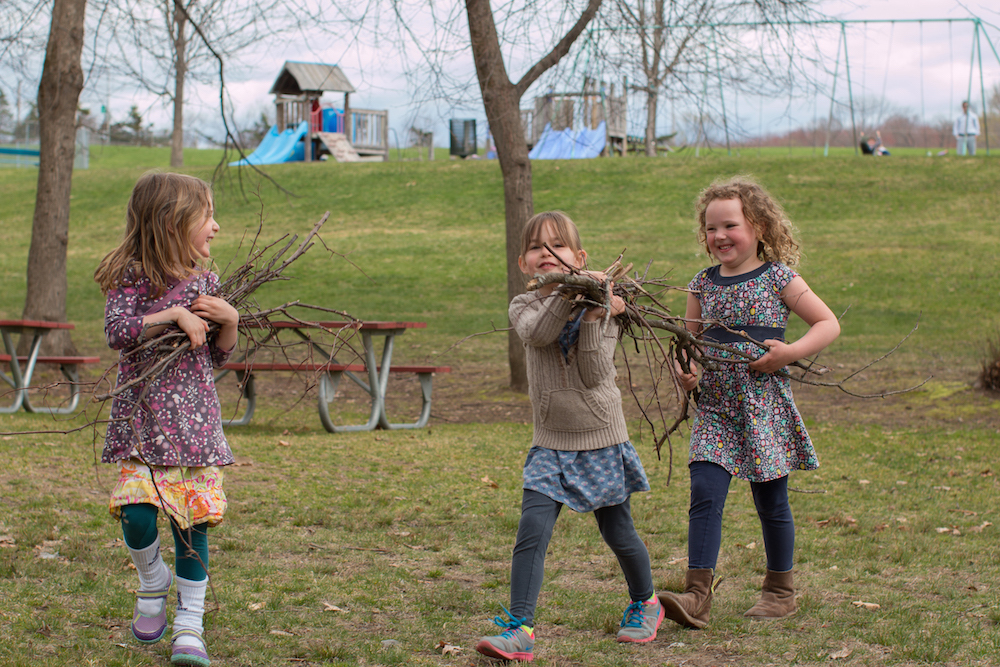Close your eyes and try to touch your finger to your nose. You could not do that without proprioception.
Often called our sixth sense, proprioception is not, in fact, the ability to talk to dead people (though we loved that movie). An easy way to think about proprioception is the feeling of pressure in the joints, ligaments and muscles of the body—the pressure sensed when our body hits up against something and gets feedback—as when we jump, push or pull something heavy.
Young children get this from activities like chewing, jumping, stomping, crawling, climbing, pushing, pulling, or stretching.
Why is proprioception important?
We use proprioception to understand, without looking, where our bodies are in space and where body parts are in relation to one another.
Proprioception also lets us know how much pressure to use when we move or interact and helps us hold our muscles when resting or maintaining our balance. This is important for most daily tasks, including walking around, sitting up, to getting a cup full of water successfully to our mouths, to giving a hug with the right pressure or playing a game of tag with friends! Kids are still learning how to manage their bodies, how to interact, and how to perform nearly every daily task, so this need for coordination and the right amount of pressure is critical for them.
Proprioceptive input also helps to center or calm our systems down. As an elementary school principal, I used to welcome teachers to offer friends who were having trouble settling into learning the invitation to bring a large book to my office. They nearly always took us up on the offer. They felt great to be helpers, and that chance to walk, climb stairs and do some “heavy work” was also so often the reset that kiddos needed.
The state of proprioception
These days, proprioception is getting the short end of the stick. Studies show that kids today spend, at best, 50% of the time we did outdoors. They've lost 12 hours of playtime out of each week since 1970, and, as a nation, we gave ourselves a D- on our US Report Card on Physical Activity for Children and Youth with more than ¾ of our kids failing to get the minimum required daily physical activity.
More and more, we spend time seated and still, interacting with screens which gives little to no input to kids' muscles and joints. All that stillness adds up to kids losing out on the kinds of activities that deliver proprioception.
What happens when proprioception is out of balance?
If a child is lacking proprioception, they will likely over-index on activities that give strong proprioceptive input such as jumping or stomping instead of walking, crashing into things, frequent chewing, or hanging off of things. If a child is hypersensitive to proprioceptive input, they may avoid activities that stimulate joints, walk lightly or slowly, use too little pressure during tasks, or struggle to sit upright.
Fortunately, the great outdoors are full of opportunities for kids to gather proprioceptive input. And, with our support, children can often decide on the level of intensity with which they engage in outdoor movement activities. If they need a lot of input, they can climb on larger logs or higher up in a tree. Need less? It’s easy to pick smaller tasks.
A few of our favorite ways to support proprioception:
- BABIES: Mouthing (Yes! Mouthing activates proprioception in the jaw!)
- BABIES: Tummy time, crawling, grasping objects
- Toddling, walking, or running
- Climbing on logs, rocks, or trees
- Throwing/catching balls
- Fort play
- Hauling sticks and other building materials
- Crawling in and out of the built fort
- Wheelbarrow walking or just crawling or spending time on all fours
- Jumping, stomping, and parading about
- Transporting heavy objects (e.g., large sticks, logs, rocks) around
- Carrying a bag or backpack with objects inside
- Blowing bubbles
- Giving nice, strong hugs (our favorite)
Keep learning about the senses!
- Read the introductory post in our sensory learning series, Making Sense of Sensory Development
- Read about our 9 favorite easy ways to support sensory development.
- Read more about a hidden sense on which all others balance—the vestibular sense.
- Sign up for Tinkergarten At Home—our free, weekly set of activities designed to engage kids in purposeful play and support parents at making it happen with whatever you have on hand.
Wondering about your child’s sensory processing?
Early on, it can feel challenging to understand what about a child’s reaction to their environment is or is not cause for concern. We may notice that our child appears to either seek or avoid proprioceptive input, but is that just part of their approach as a learner? And, will they thrive in time given regular opportunities to engage in activities that offer proprioceptive input? Or, might a child struggle with integrating sensory input in such a way that they would benefit from specific, expert support?
If you are concerned, connect with doctors and school staff (if applicable). Organizations like Understood.org and the Child Mind Institute that offer accessible resources and supportive community.
